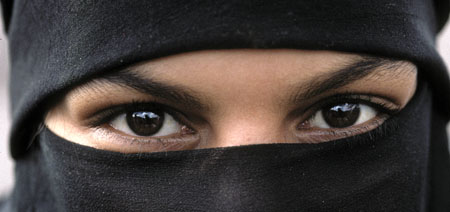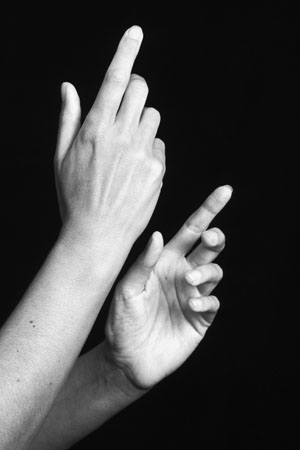 Eyes, hands, legs and feet, seen in isolation, often say a great deal about people and their way of life, and consequently make interesting photographic subjects. This gives rise to a quite different approach to photographing people.
Eyes, hands, legs and feet, seen in isolation, often say a great deal about people and their way of life, and consequently make interesting photographic subjects. This gives rise to a quite different approach to photographing people.
Eyes are of course the windows of the soul. They are the very essence of portraiture because they convey sentiment and mood in subtle ways. Eyes narrow in anger and widen in amazement. They smile with pleasure, glaze when distracted and moisten with emotion. The challenge for the photographer is to bring the appropriate feeling to an image.
Even when considered in isolation, eyes make a fascinating subject. Shots framed so tightly that only the eyes are visible usually grab attention, but those that also convey emotion have the most impact. Framing and composition for images of this type are not as easy as one might think. Wherever the cut-off occurs on the face it can seem uncomfortably placed. One solution is to choose a subject wearing an item of clothing that frames the eyes, such as a scarf or veil. This creates a softer and more acceptable boundary than the clean rectangle defined by a viewfinder. Compositions of this type may be more successful if the subject's head is tilted to one side so that the eyes are on different levels.
 With a pair of eyes comfortably filling a 35mm or DSLR frame in landscape format, depth of field will be minimal and dependent upon aperture only. At f/2.8 it is less than five millimetres, and at f/22 it is approximately 30mm. It is usually the case that both eyes should be in sharp focus, although under some circumstances one may be allowed to go soft. Focusing should therefore be very precise, and depth of field must be carefully controlled. Close-ups of eyes composed in camera tend to work better than enlargements obtained from more distant shots. Images are more likely to have the desired impact when seen and captured as originally visualized. A micro lens having a short minimum focusing distance is therefore an advantage.
With a pair of eyes comfortably filling a 35mm or DSLR frame in landscape format, depth of field will be minimal and dependent upon aperture only. At f/2.8 it is less than five millimetres, and at f/22 it is approximately 30mm. It is usually the case that both eyes should be in sharp focus, although under some circumstances one may be allowed to go soft. Focusing should therefore be very precise, and depth of field must be carefully controlled. Close-ups of eyes composed in camera tend to work better than enlargements obtained from more distant shots. Images are more likely to have the desired impact when seen and captured as originally visualized. A micro lens having a short minimum focusing distance is therefore an advantage.
The hands of a rugged farm worker will be quite different in appearance from those of an office worker or a child. Those of an elderly subject may be deeply wrinkled and make the viewer want to see more of their owner. Capture the hands clasped, perhaps with the fingers intertwined, or simply holding a small object. Directional light is important because it highlights texture. Hands can also be photographed as a frame for the face. One way to do this is to position someone behind a screen, and ask him or her to look through a restricted opening held ajar by relaxed hands. Venetian blinds or an old tarpaulin are good for this purpose, but many other approaches are possible.
Legs seen in isolation are subjects in their own right - indeed whole books have been written about them. The muscular thighs and calves of an athlete, or the graceful and geometric poses of a dancer, provide sufficient interest to attract the eye. With good composition, an uncluttered background, and directional lighting to provide modelling, simple ideas such as these can be very successful.
 Feet are of interest in a more intimate way. The compound curves and the texture of the skin make us curious about their owner. Are these the feet of a man or a woman? How old are they and what sort of life have they led? Feet can be photographed in a straightforward manner and portrayed as the parts of the body that make contact with the ground. They can also be seen as a sculptural abstraction rich in form, texture and outline. This latter approach needs directional light, and is probably best tackled in a studio where lighting is fully controlled and precise.
Feet are of interest in a more intimate way. The compound curves and the texture of the skin make us curious about their owner. Are these the feet of a man or a woman? How old are they and what sort of life have they led? Feet can be photographed in a straightforward manner and portrayed as the parts of the body that make contact with the ground. They can also be seen as a sculptural abstraction rich in form, texture and outline. This latter approach needs directional light, and is probably best tackled in a studio where lighting is fully controlled and precise.






